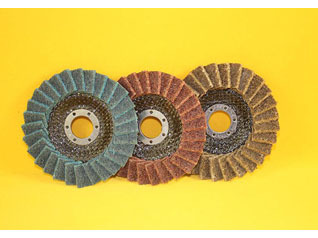RMN carries the best flap discs in a variety of sizes and materials available from mini 2”, 3” to larger 4.5” and 7”. We offer abrasives wholesale as flapper discs in Zirconia as well as ceramic grains in 40, 60, 80 & 120 grit. Additionally, we carry specialty flap discs such as high density, surface conditioning discs, and felt polishing flaps.
A flap disc is an abrasive attachment made up of multiple layers of “flaps” of overlapping abrasive, sandpaper-like, sections adhered to a central hub in a wheel design.
As the flap disc is used to grind metal or other surfaces, the abrasive material will grind down. Once the material on the outer layer is used up, that sheet will automatically tear off to expose a fresh layer of abrasives.
The “type” of design for flap discs specifies the angle that the abrasive sheets are aligned into the wheel.
◬T27 - Flat Discs
Type 27 flap discs are flat across the entire disc. This generally makes the preferred choice for smoothing/blending surfaces as well as flat sanding. Using an angle grinder, T27 flap discs should be used from a 0-15° angle from the surface.
◬T29 - Conical Discs
Type 29 flap discs have their abrasive sheets have a slight angle on the face of the disc. This design allows for more aggressive grinding and is usually preferred for contouring and shaping surfaces. Using an angle grinder, T29 flap discs should be used from a 15-25° angle from the surface.
Just like most other abrasive products, there is a variety of different abrasive grain types that can be used for flap discs and each has their own purpose.
▸Zirconia is the most common grain used for flap discs. It is a tough abrasive with a high cut rate that can grind strong metals like stainless steel and titanium. The grains are self-sharpening which significantly reduces downtime while working.
▸Ceramic flap discs are another strong abrasive that can grind metal surfaces from carbon steel to aerospace alloys. Like zirconia, ceramic is a friable abrasive grain that continuously exposes new sharp grains, so you can keep working without a dulling disc. A key feature that sets ceramic flap discs apart from others is the low temperature buildup compared to other materials.
▸Aluminum Oxide is the best flap disc for aluminum and other soft metals. When combined with a white calcium stearate coating, these discs prevent clogging (chip adhesion) which could damage the soft metal being worked on.
✴Flaps
The actual sheets are made up of a polyester cloth bonded with abrasive grains, similar to the makeup of sand paper. The grains are available in different grits as well as different materials such as zirconia, aluminum oxide, and ceramic grains.
✴Backing Plate
The backing plate is crafted with a strong fiberglass plate. Fiberglass makes for a lightweight, but rigid backing that is capable of absorbing a notable amount of vibrations creating from grinding any surface.
✴Specialty Flap Discs
Traditionally, flap discs have overlapping sheets of sandpapers, but in recent years the innovative design has been used to create new products by incorporating materials such as Australian wool for polishing, and nylon webbing for surface conditioning. Each of these varieties has the same fiberglass backing and metal hub, except for the mini quick change discs that use a plastic Type R Roloc-like attachment for die grinders.
